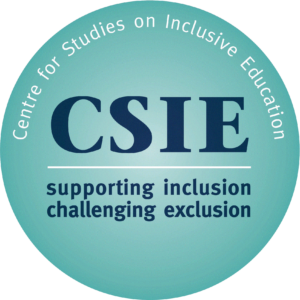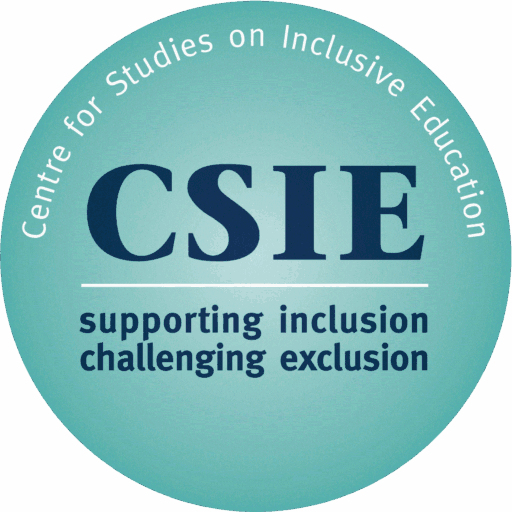I. Vision
CSIE seeks to transform education so that everyone can feel welcome, visible and respected in their local school. (NB Throughout this Strategy Paper ‘school’ is taken to mean any provider of Early Years, Primary, Secondary, Further or Higher Education and “child” refers to any young person up to the age of 18.) We see inclusive education as an optimum learning environment, an effective way to eliminate prejudice and an important step towards an inclusive society, where minority groups are no longer marginalised or excluded. CSIE activities focus on the change that needs to take place, so that everyone’s right to equality and non-discrimination can be upheld. Our work is underpinned by the following principles:
- Equality and respect: We believe that everyone is of equal value, by virtue of being human. Age, (dis)ability, sex, gender identity, sexual orientation, ethnicity, religion or belief, or socioeconomic background have no part in determining personal worth. We believe that diversity should be celebrated and utilised as a rich learning resource.
- One school for all:We recognise the uncompromised right of every child to a good education in their local community, as enshrined in national and international legislation. We understand schools’ selection procedures, for example on grounds of faith, perceived ability or socioeconomic status, to operate against the principle of equal opportunity. We also understand the existence of separate special schools as a remnant of a previous era, when disabled people were excluded from mainstream society.
There are currently footnote 4 271,200 school pupils in England who have an Education, Health and Care Plan. 43.8% of these children attend maintained “special†schools, 1.3% non-maintained “special” schools and 0.8% Pupil Referral Units. Recent CSIE research footnote 5 has confirmed a national rise in special school placements and a tenfold difference in the rates of segregation into special schools of children with Education, Health and Care Plans.
This widespread segregatory practice seems to be based on historically established expectations, i.e. on a general assumption that ‘special school is where these children go to’. This is widely considered unproblematic, even though it can hinder children’s life chances and is at odds with society’s stated commitment to disability equality, and with national policy and legislation. In other parts of the world education has transformed and all children are educated in mainstream schools.
The Equality Act 2010 protects people from harassment and discrimination, but education often lets them down. National and international legislation and guidance stipulate every child’s right to a good education without discrimination. In practice many schools, local authorities and academy chains discriminate against people from minority groups and are rarely being challenged.
III. Theory of change
CSIE’s Theory of Change, based on the personal and professional knowledge of staff and trustees, explains why CSIE addresses equality through the lens of disability. It presents our view that routine practices and behaviour patterns which seem commonplace and unproblematic to some, act as barriers to the presence, participation or achievement of disabled people. It also states our view that the power to develop more inclusive schools for disabled children and young people rests with: central government; local authorities; multi academy trusts; schools and other educational settings; individual educators; and, to some extent, parents.
In determining where CSIE can have the strongest impact, it identifies awareness-raising as the most important lever to guard against institutional prejudice, and practical support for local authorities, schools and other educational settings to build capacity to include the full diversity of children and young people. Practical support takes the form of training, information, resources, reviews of policies and/or curriculum, support to carry out whole school equality audits, and acting as a critical friend in the process of inclusive school development. The full document is available on request.
V. The levels at which organisations can intervene
There are four levels at which intervention can be made:
- The level of individual children.
- The level of family and community.
- The level of services: schools and other educational settings.
- The level of society: national policy and legislation, public awareness.
VI. CSIE’s current strengths and capacity
The Centre is well-known in the education world and CSIE resources are highly regarded. Existing capacity suggests that CSIE activities should concentrate at the level of services and the level of society. This complements the work of other organisations, many of which work at the level of the individual (such as MENCAP, Scope, RNIB, RNID, NAS, DSA, SARI, EACH, Gendered Intelligence, Beat Bullying UK and others) while others focus on the family and community level (such as Barnardo’s, ACE, IPSEA, Network 81 and others).
CSIE has strong links with other organisations that focus on the level of services and/or society (such as World of Inclusion, Alliance for Inclusive Education, Parents for Inclusion, Schools Out UK and LGBT History Month) with whom we plan to maintain our connections.
VIII. Implementation
Each key objective listed above is supported by an Implementation Plan which outlines how the objective will be achieved, as well as by a series of performance indicators which help Trustees monitor progress. These are available on request from admin@csie.org.uk. This Strategy is reviewed annually in September. Implementation is the responsibility of the CSIE director, who submits a quarterly report to Trustees. Progress and achievements are described in CSIE’s annual report, usually available in June each year.
Footnotes
Footnote 1: https://researchbriefings.parliament.uk/ResearchBriefing/Summary/CBP-8537
Footnote 2: www.gov.uk/government/publications/hate-crime-action-plan-2016
https://assets.publishing.service.gov.uk/
Footnote 3: www.childrenssociety.org.uk/what-we-do/our-work/young-refugees-migrants
Footnote 4: www.gov.uk/government/statistics/special-educational-needs-in-england-january-2019
Footnote 5: https://www.csie.org.uk/trends/report2019.pdf
Footnote 6: https://documents-dds-ny.un.org/doc/UNDOC/GEN/G16/149/88/PDF/G1614988.pdf?OpenElement
Footnote 7: https://tbinternet.ohchr.org/_layouts/15/treatybodyexternal/Download.aspx?symbolno=CRPD%2fC%2fGBR%2fCO%2f1&Lang=en


